Institutional investors can join our live chat on Bloomberg, a groundbreaking venue, just email tatiana@thebeartrapsreport.com – Thank you. LGM
Broken Markets, Beyond Silly
Now we have seen everything. AMC´s 5.25s due in 2025 closed down a quarter-point at 79.796 cents on the dollar vs. the AMC equity 95% higher at $62.55.
“After 30 years of trading stocks and bonds, 95% of the time I can assure you, credit leads equities. That´s a 12.25% yield to worst vs. 5 year Treasuries at 0.79%. Sell Mortimer, sell AMC equity.”
Larry McDonald, Creator of the Bear Traps Report.
Bonds are Telling You AMC Shares are Smoking in the Dynamite Shed
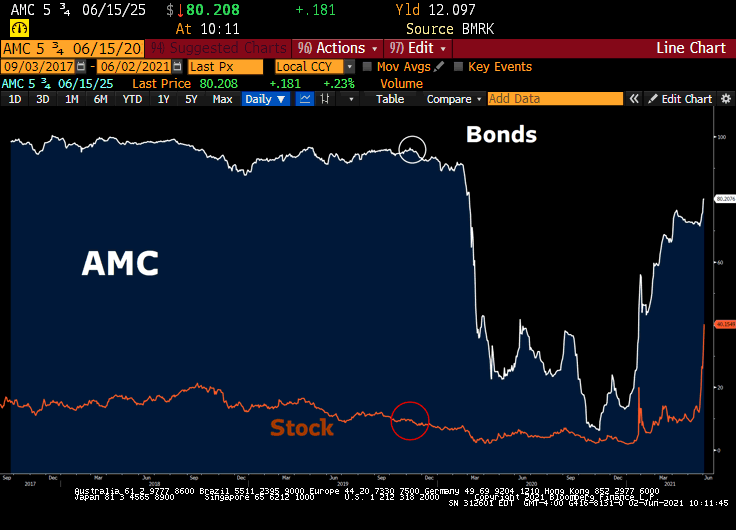 AMC 5.75% due 2025 are offered at 81 cents on the dollar. Meanwhile, the stock is trading at all-time highs. Disconnect. In the old days when capital structure arbitrage actually worked, you’d buy bonds and buy puts in the dollar amount of the next coupon payment if you thought bonds were worth par under a bankruptcy scenario. The put expiry would be for the month the next coupon is paid. You’d play this game every six months until it worked. But markets are so screwed up who knows if it would work anymore. What we know for sure is that the bond and the stock disagree about the risks inherent in AMC’s future.
AMC 5.75% due 2025 are offered at 81 cents on the dollar. Meanwhile, the stock is trading at all-time highs. Disconnect. In the old days when capital structure arbitrage actually worked, you’d buy bonds and buy puts in the dollar amount of the next coupon payment if you thought bonds were worth par under a bankruptcy scenario. The put expiry would be for the month the next coupon is paid. You’d play this game every six months until it worked. But markets are so screwed up who knows if it would work anymore. What we know for sure is that the bond and the stock disagree about the risks inherent in AMC’s future.
AMC
November 2019
Bonds 96 cents
Stock $9.50
May 2021
Bonds 80 cents
Stock $40.04
Central Banks and Market Dysfunction
With today’s endless central back accommodation – Lehman Brothers NEVER would have failed, fact. That´s what “un-free markets” have become in a world where Adam Smith’s “invisible hand” has been tied behind his back. When the cleansing process of the business cycle is NOT allowed to function over longer and longer periods of time, the moral hazard buildup will trigger a transformation into another serpent, another beast. The next Lehman awaits, just a different flavor, dressed up in unrecognizable packaging.
The fundamental problem with aggressive accommodation from central banks comes down to a market foundation built on moral hazard. Each day, week, and month the Federal Reserve provides more juice, the leverage piles up in pockets all over the planet. Of course, central bankers often do not see the toxic leverage until it is far too late. We are led by academics, NOT proper risk managers. Herein lies the conundrum. While providing excessive accommodation (the Fed is currently making $120B of asset purchases monthly), when traditional shocks arrive – as they always have – the loose fiscal policy will be untenable and looser monetary policy, inconceivable. The market is ill-prepared today – far less so than under normal conditions historically.
Don’t miss our next trade idea. Get on the Bear Traps Report Today, click hereShares Complete with Butter, Comedy
Beginning today, shareholders can sign up to receive special offers and investor updates by registering at amctheatres.com/stockholders.
“Investors who sign up starting today and in the coming weeks will be awarded with an initial free large popcorn usable this summer when attending a movie at an AMC theatre in the United States. The offer will be made available in their AMC Stubs rewards account.” AMC

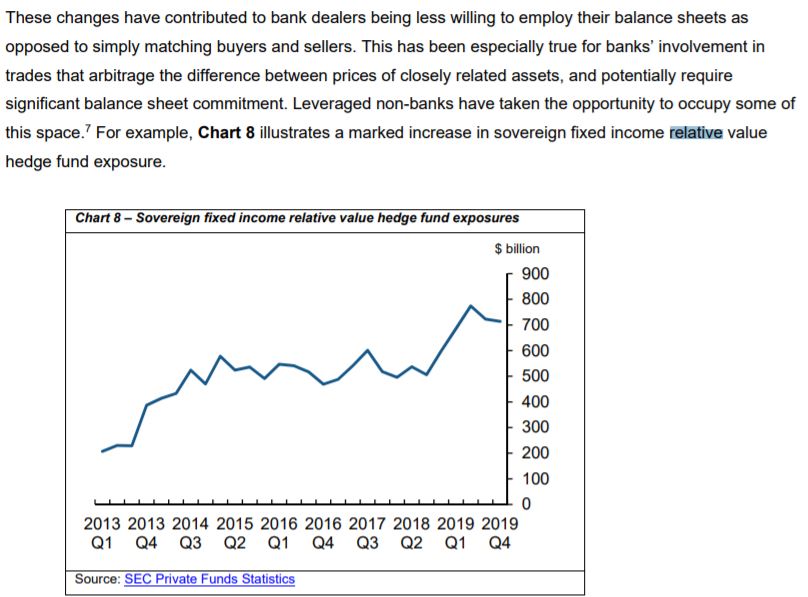
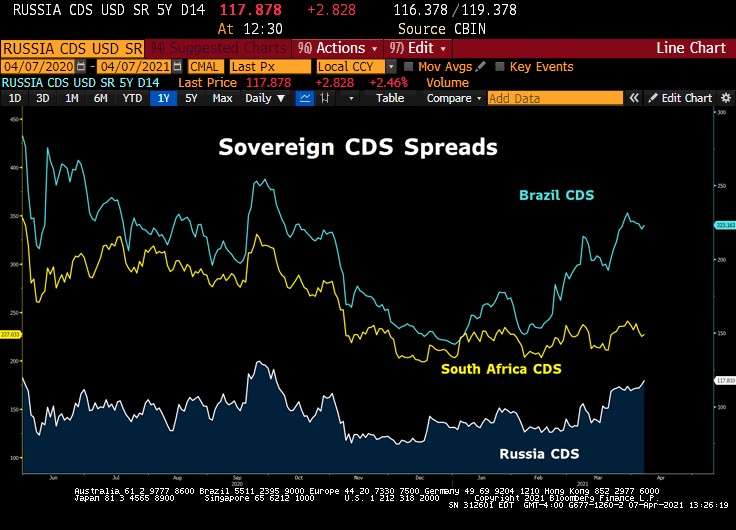 So far there is some evidence of additional risk being priced into risk assets. The cost of credit default protection on Russian sovereign debt is underperforming vs. South Africa and other emerging market counties, but not Brazil.
So far there is some evidence of additional risk being priced into risk assets. The cost of credit default protection on Russian sovereign debt is underperforming vs. South Africa and other emerging market counties, but not Brazil. 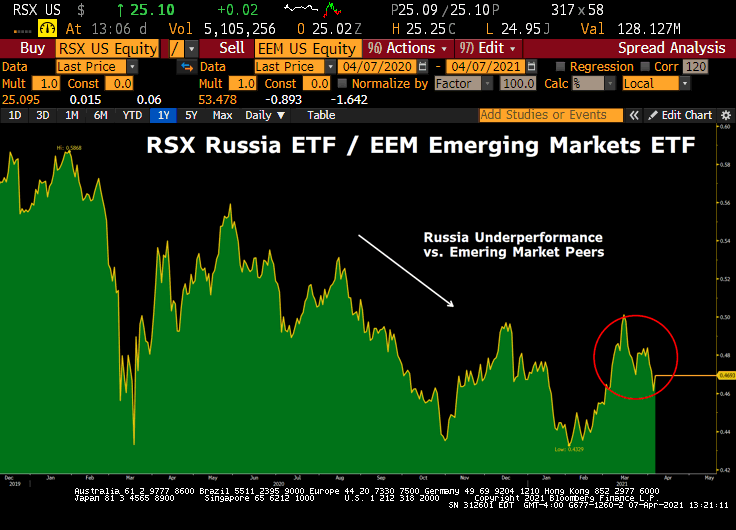 Clearly, some Ukraine – Russia conflict is being priced in here. Notice the recent under-performance of RSX Russian equities relative to the mothership EEM.
Clearly, some Ukraine – Russia conflict is being priced in here. Notice the recent under-performance of RSX Russian equities relative to the mothership EEM. 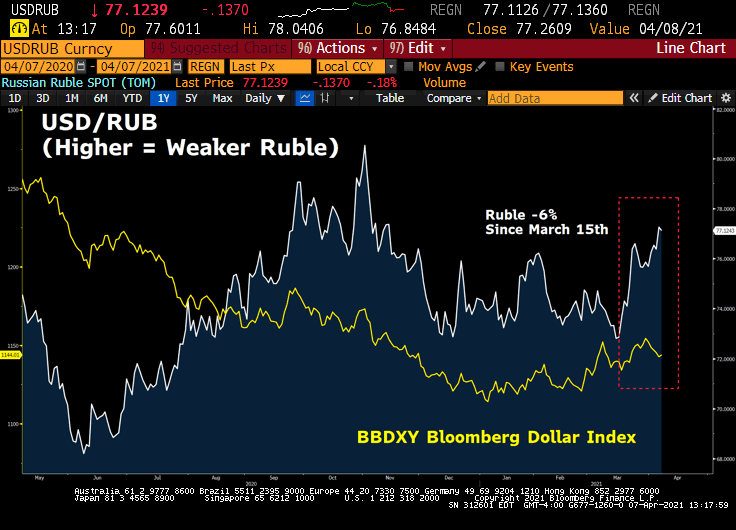 At the
At the 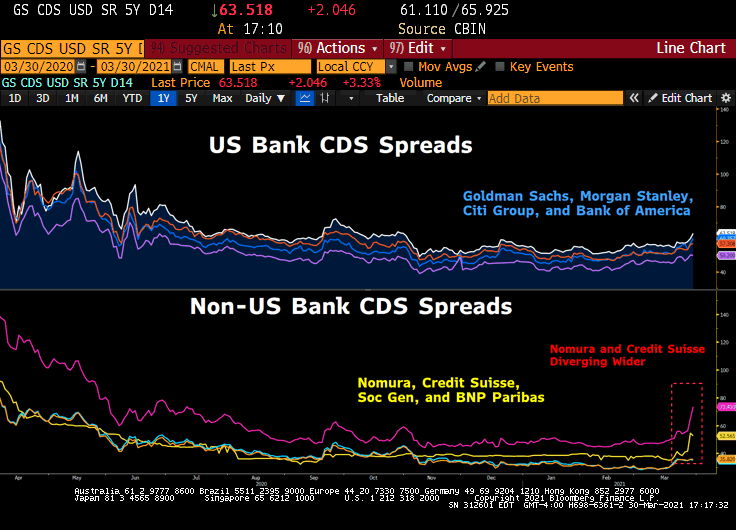
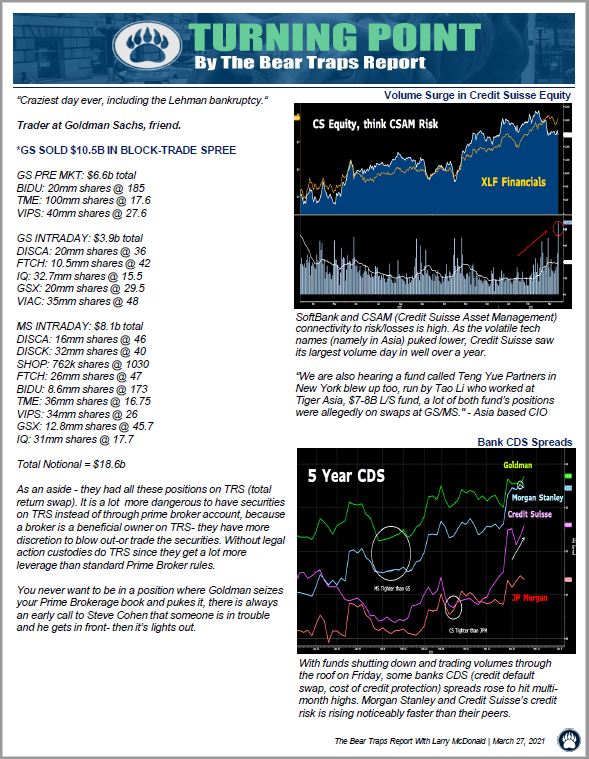 The epic sale of stock in the Archegos unwind (see above) will leave a dark stain on Wall St. for years to come. The Credit Suisse mess is larger than what’s priced into the market. It’s NOT a Lehman size failure but they will be forced into asset sales (CSAM), and or a size rights offering. It’s beyond sinful in financial terms that PB (Prime Broker) risk across the street has such a disgusting lack of transparency. All of this will force a “come to Jesus” for the Street’s compliance departments and force a meaningful de-leveraging. Then come the regulators and House / Senate hearings. Keep in mind, this same problem went down in January with Robinhood, they could NOT properly and efficiently quantify counterparty risk during the trading-day and were forced into a capital raise. So, Q1 2021 will be forever marked by a period of reckless risk-taking breaking the system.
The epic sale of stock in the Archegos unwind (see above) will leave a dark stain on Wall St. for years to come. The Credit Suisse mess is larger than what’s priced into the market. It’s NOT a Lehman size failure but they will be forced into asset sales (CSAM), and or a size rights offering. It’s beyond sinful in financial terms that PB (Prime Broker) risk across the street has such a disgusting lack of transparency. All of this will force a “come to Jesus” for the Street’s compliance departments and force a meaningful de-leveraging. Then come the regulators and House / Senate hearings. Keep in mind, this same problem went down in January with Robinhood, they could NOT properly and efficiently quantify counterparty risk during the trading-day and were forced into a capital raise. So, Q1 2021 will be forever marked by a period of reckless risk-taking breaking the system.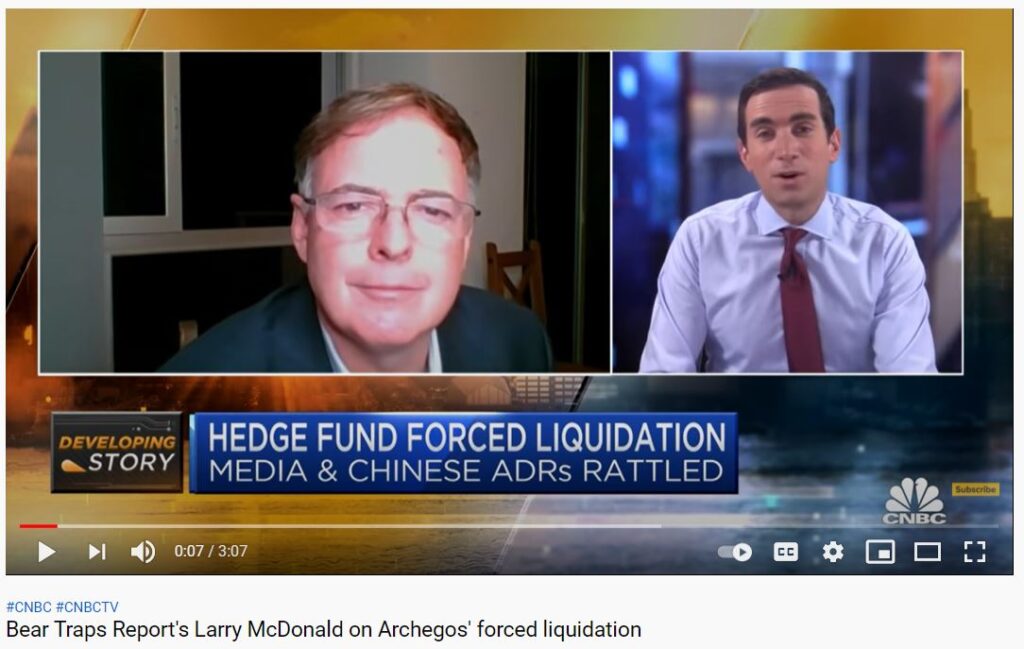 Our Larry McDonald, author of a “Colossal Failure of Common Sense”, and Andrew Ross Sorkin of “Too Big to Fail” fame –
Our Larry McDonald, author of a “Colossal Failure of Common Sense”, and Andrew Ross Sorkin of “Too Big to Fail” fame – 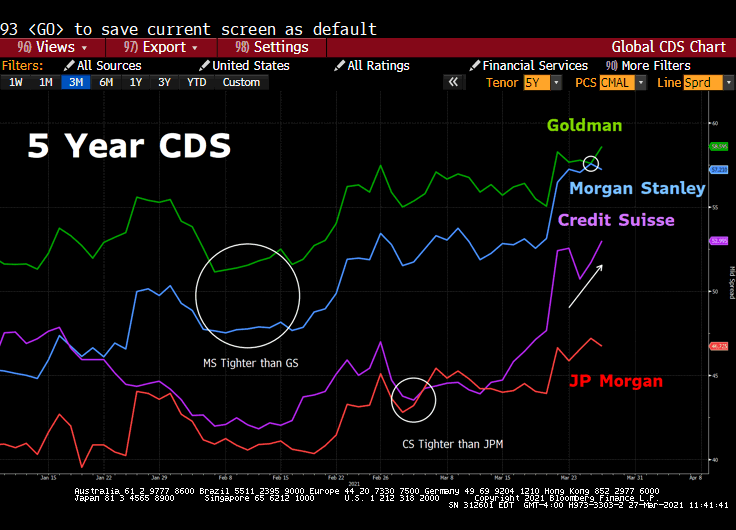 All the signs were there Friday. Banks with credit risk tied closest to hedge fund blow-ups dramatically underperformed.
All the signs were there Friday. Banks with credit risk tied closest to hedge fund blow-ups dramatically underperformed.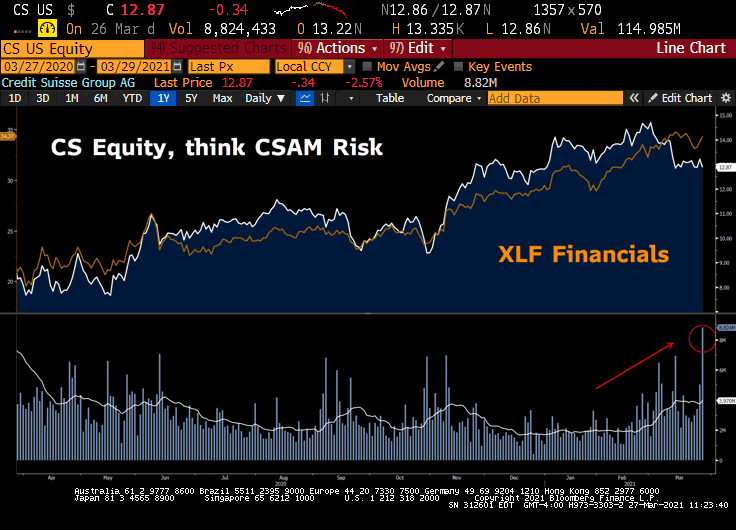 Friday’s volume was pointing to some real issues. In recent weeks as the Lex Greensill debacle sucked more oxygen out of the air, CS equity has been dramatically underperforming. Institutional clients in our live chat were asking this week if Nomura’s pain is $2-4B, doesn’t that put CS in the $6-8B range? Any capital issues for the bank? Do they have to start de-risking or seek to raise more capital? All at quarter-end? With $275B of risk-weighted assets by the end of 2020 and a 12.5 CET1 ratio, this equals $34.375B capital. Clients we trust see a high risk of impairments.
Friday’s volume was pointing to some real issues. In recent weeks as the Lex Greensill debacle sucked more oxygen out of the air, CS equity has been dramatically underperforming. Institutional clients in our live chat were asking this week if Nomura’s pain is $2-4B, doesn’t that put CS in the $6-8B range? Any capital issues for the bank? Do they have to start de-risking or seek to raise more capital? All at quarter-end? With $275B of risk-weighted assets by the end of 2020 and a 12.5 CET1 ratio, this equals $34.375B capital. Clients we trust see a high risk of impairments.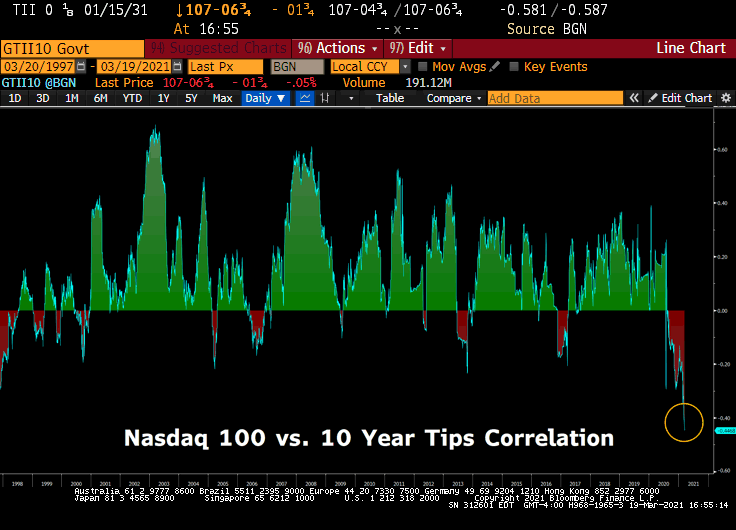 A colossal portion of “growth” stocks have their true worth embedded in the “net present value” of FUTURE cash flows. Thus, as bond yields and inflation expectations rise – tech stocks are worth a lot less.
A colossal portion of “growth” stocks have their true worth embedded in the “net present value” of FUTURE cash flows. Thus, as bond yields and inflation expectations rise – tech stocks are worth a lot less.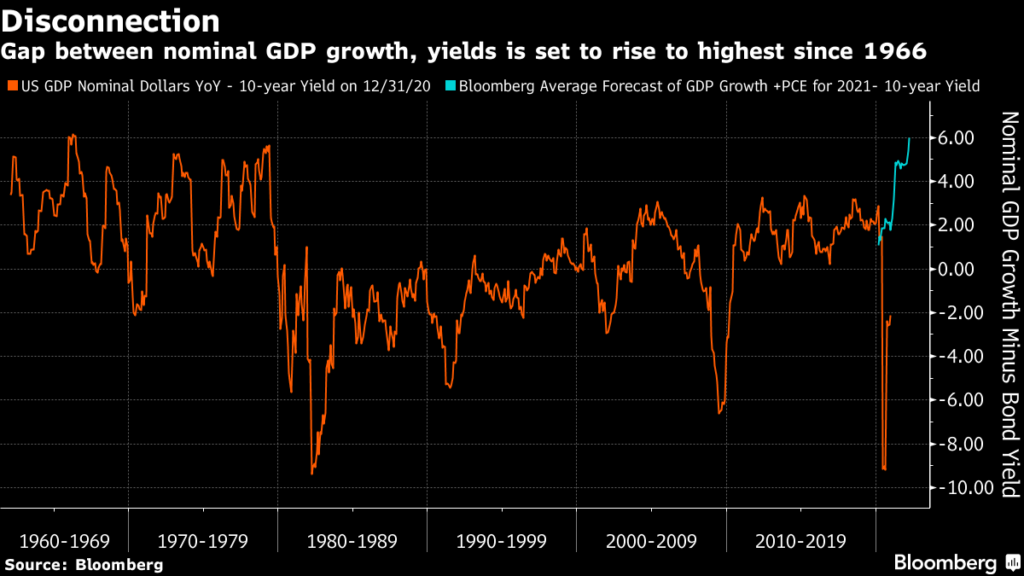 The Street is up at 6-7% 2021 GDP growth expectations. BUT, including the inflation outlook – nominal GDP growth could be nearly 10% in 2021, but comparisons get tough in 2022 with growth estimates falling below 3%.
The Street is up at 6-7% 2021 GDP growth expectations. BUT, including the inflation outlook – nominal GDP growth could be nearly 10% in 2021, but comparisons get tough in 2022 with growth estimates falling below 3%.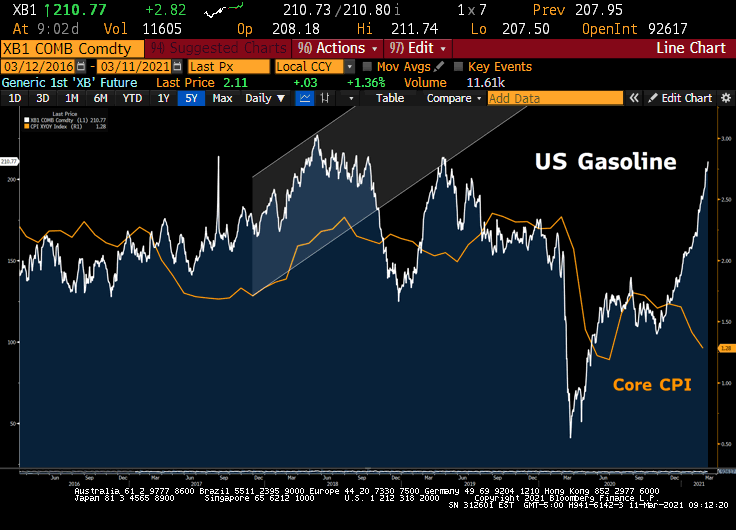 Gasoline is testing its five year highs and Core CPI is down. Say what? How can that be? Is the government manipulating inflation measures so it can keep its money printing presses running hot? Of course! But there’s more to the story than that. As to highly questionable lower inflation readings, it’s true. The components have changed over the decades such that if one were to calculate CPI using the 1980 formula, it would be more than twice as high as the current reading! But there is another less nefarious (or blindingly stupid) reason. An increase in gasoline prices is a tax on consumer demand. A person making $45k a year only has so much money to spend. And every dollar made is spent. So if an extra dollar goes to gas, that is one less dollar to a component of Core CPI. So higher gasoline prices take demand away from other goods and services. Higher gasoline prices exert deflationary pressure on other goods and services.
Gasoline is testing its five year highs and Core CPI is down. Say what? How can that be? Is the government manipulating inflation measures so it can keep its money printing presses running hot? Of course! But there’s more to the story than that. As to highly questionable lower inflation readings, it’s true. The components have changed over the decades such that if one were to calculate CPI using the 1980 formula, it would be more than twice as high as the current reading! But there is another less nefarious (or blindingly stupid) reason. An increase in gasoline prices is a tax on consumer demand. A person making $45k a year only has so much money to spend. And every dollar made is spent. So if an extra dollar goes to gas, that is one less dollar to a component of Core CPI. So higher gasoline prices take demand away from other goods and services. Higher gasoline prices exert deflationary pressure on other goods and services. 
